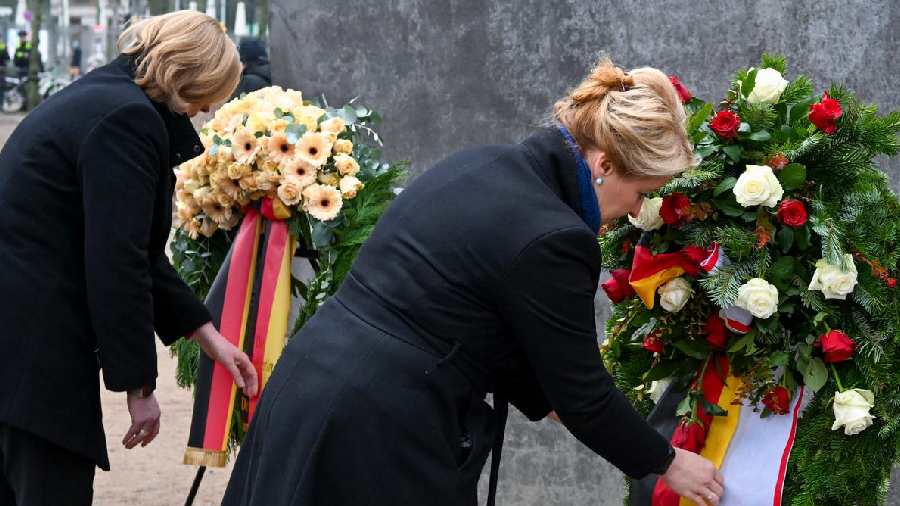"Now you're a gay pig and you've lost your balls." That was how Otto Giering was taunted by a guard in August 1939 after his forced castration in the Sachsenhausen concentration camp. Even before his deportation to the concentration camp, the 22-year-old had been convicted twice for homosexual contact and sent to a labor camp.
The harrowing story of the Hamburg-born journeyman tailor can be read in the book "Medicine and Crime," published by the Brandenburg Memorials Foundation, to which the Sachsenhausen concentration camp memorial and museum belongs.
Otto Giering survived the ordeals, but his health was ruined: "Due to the concentration camp imprisonment he had heart problems, stomach problems, suffered from headaches and migraines," the book recounts.
Later, his application for compensation was rejected, and he did not come home for days and was reported missing. "The police found him confused and disoriented," the book says.
Otto Giering died in 1976, a few months before his 60th birthday. He was one of an estimated 10,000 to 15,000 gay men who were deported to German concentration camps by the end of the Nazi era in 1945. In Sachsenhausen alone, there were about 1,000, more than in any other concentration camp. Along with Jews, Sinti and Roma, they were those most abused by the guards.
Gay men murdered
Gay men, forced to wear a pink triangle badge on their prisoner clothing, were often put into punishment "commandos" with tougher working conditions. This included work in the so-called "Klinkerwerk" — a subcamp of Sachsenhausen where, among other things, they were forced to manufacture armaments.
In 1942, 200 gay people were systematically murdered at this site, and the deaths of more than 600 gay prisoners were recorded in the concentration camp north of Berlin. Although the fate of gay men during the Nazi era had been documented many times, it took decades for marks of public remembrance to appear. There was no plaque commemorating gay victims of the Nazis at the Sachenhausen memorial until after the reunification of Germany in the early 1990s.
Late remembrance and rehabilitation
The first attempts to commemorate gay men persecuted in Sachsenhausen had already been made earlier when the concentration camp lay in East Germany. Memorial spokesman Horst Seferens told DW that members of the West Berlin gay movement laid wreaths with pink ribbons, which were immediately removed by the Ministry for State Security (Stasi).
"In the meantime, this group of victims, which has been represented on the advisory board of our foundation since 1993, is present in many ways in the exhibitions and in the other work of the memorial," Seferens emphasized.
There are several reasons for the late start of official remembrance and moral rehabilitation: On the one hand, this is related to the fact that practiced homosexuality was considered a criminal offense in both German states after 1945, although liberalization began much earlier in East Germany than in West Germany.
Seferens, noted differences between East and West in commemorating the victims of the Nazis. "In the GDR, in line with anti-fascist state doctrine, it was the political prisoners who were in focus," he said. And in the Federal Republic, it was the military officers who plotted against Hitler and later the Jewish people who were commemorated, he explained.
"For decades, many other victim groups — those persecuted as "anti-socials," Sinti and Roma and gay people – were excluded from commemorations and denied financial compensation. "This sheds light on continuities of stigmatization and exclusion mechanisms that extend far beyond 1945," said Seferens.
Homosexuality was illegal long before the Nazis came to power in Germany in 1933, as was set down in paragraph 175 of the Reich Penal Code of 1871, the year the first German Reich was founded. "Unnatural fornication" between men fell under this paragraph, defined as "crimes against morality." The Nazis massively tightened the penal provisions and introduced Paragraph 175a in 1935 prohibiting all "lewd acts" between men.
Lesbian women were also denounced for their "deviant" sexuality and came under police scrutiny, but in terms of criminal law, they were mostly spared. The situation was different only in Austria, which joined Nazi Germany in 1938, and where there was no legal distinction between male and female homosexuality.
Overall, the fate of lesbian concentration camp inmates is much less researched than that of gay men, as there was no separate inmate category for them. Lesbian women were sent to concentration camps under various labels: As "anti-socials," homeless, prostitutes, or women categorized as having an "immoral lifestyle."
the pressure of persecution was constantly increased, especially on men. Immediately after taking power in 1933, the Nazis shut down all gay and lesbian subculture venues and disbanded the Institute for Sexual Science in Berlin, founded by Magnus Hirschfeld in 1918.
The Nazis' hatred of Hirschfeld, a pioneer of the gay movement, was only compounded by his Jewish faith. In 1936, the year of the Berlin Olympics, the Nazis founded the "Reich Central Office for the Combating of Homosexuality and Abortion." Gay people in particular were targeted for persecution after the office gathered data on citizens. Around 100,000 investigative proceedings were initiated during the Nazi era, and about 50,000 men were convicted.
Not rehabilitated until 2002
Even after the Nazi regime ended, Paragraph 175 remained in force in both the Federal Republic and the GDR. It was not finally abolished until 1994, four years after reunification, and it took until 2002 for the German Bundestag to rehabilitate those convicted by Nazi judges. Most of them had already died by then.
As it has done every year since 1996, the German Bundestag is commemorating all victims of Nazi rule on January 27, the date of the liberation of Auschwitz. This year's anniversary focuses on the LGBTQ community, exactly 90 years after the Nazis came to power.










